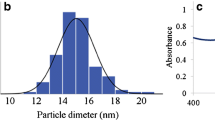Abstract
The design and characteristics of a novel drop-based fluorescence-detection technique for the determination of mercury(II) are described. The method, using a flow injection technique, is based on the renewable-drops of 3,3′,5,5′-tetramethylbenzidine(TMB), which are formed at the bottom tip of a silica capillary tube connected to the end of the flow system. An excitation beam from a high-pressure Hg lamp directly illuminates the drops, the fluorescence emission is conducted to a photodiode (PD) to convert the photocurrent into a voltage signal (mV). Optimum analytical conditions for Hg(II) assays have been established. In NaAc/HAc buffer at pH 3.09 this assay has a wide linear range for Hg(II) from 8.0 × 10–8 to 2.0 × 10–5 mol/L with a detection limit of 2.0 × 10–8 mol/L. The use of renewable drops allowing a fresh reaction surface for each sample is of particular value to solving the problems of ¶irreversible reactions. Besides its high sensitivity, the method permits a simple, fast, and inexpensive measurement with only micro-quantities of reagent consumption. The technique described provides a simple and sensitive way to fabricate sensors of feasible prospects and commercial advantages.
Similar content being viewed by others

Author information
Authors and Affiliations
Additional information
Received: 6 June 2000 / Revised: 6 September 2000 / Accepted: 10 September 2000
Rights and permissions
About this article
Cite this article
Yang, R., Wang, K., Xiao, D. et al. Determination of low-level mercury based on a renewable-drops sensing technique. Fresenius J Anal Chem 368, 797–802 (2000). https://doi.org/10.1007/s002160000599
Issue Date:
DOI: https://doi.org/10.1007/s002160000599



